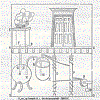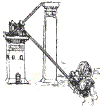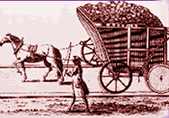
![]()

 A PEEP INTO HISTORY
A PEEP INTO HISTORYPower of Steam - What was invented first ?
The Gauge,-
Who invented steam locomotive ? The rainhill trial,
Progress of Railway revolution,
Prejudice and opposition

BHOLU THE GUARD
Some
earliest steam powered engines claimed to be used in ancient times.
click thumbnail to enlarge




(FRANCE) In 1641 Marion de Lorme and the Marquis of Worcester visited together one of the Paris madhouses. Looking through the bars of his cell was a man named Solomon de Cause.
"I am not mad," he cried to the visitors, "I am not mad! But I have made a discovery that would enrich the country that would adopt it. But I am not mad. I am not mad."
"The poor creature says that he has discovered a wonderful power in the use of steam from boiling water," explained the keeper. "He came from Normandy, about four years ago, to present to the king a statement of the wonderful effects that might be produced from his invention. Cardinal Richelieu sent him away without listening to him. Solomon persisted, and, following the cardinal wherever be went, finally so annoyed him with his discovery that he had him shut up in the Bicetre as a madman."
The Marquis of Worcester, not being dependent upon Richelieu, went back to England to work at the same problem that had cost Solomon de Cause his liberty. He succeeded so well that in 1656 he erected in London a machine which "raised water more than forty feet by the power of one man only." What the machine was used for, or if it was used for anything, we are not told.
After this, however, progress
was more rapid, and in 1718 steam was for the first time put into industrial
harness by a Cornish miner named Savary, who built an engine to pump water from
the mines. Forty seven years later in 1765 - James Watt constructed
his first steam engine at the Corson Iron Works, Glasgow, Scotland and the steam age began.
It believed that the great painter and artist Leonardo da Vinci was a great
inventor also. The picture on the left what he visualised as a water pump
through steam.
You can have a look at this page also :
World Rail Development

Even in early 16th Century, in England there were metalled tracks for horse-hauled trucks

Miners' hand cart

mining wagons on wooden wagonways
What was invented first ? The Railways or the Steam Engine ?
Though even before the age of steam engines, i.e., even in early 16th Century, in England there were metalled( built with stone linings) tracks for horse-hauled trucks, the earliest is in
1630 - when a man named Beaumont laid rails on a highway in England to transport coal from the Newcastle mines. This is the first railroad known in history.Strictly speaking , the history of Railways goes back much further in time. Traces of evidence are still available which establish that in devastated Pompeii, ancient Greece and even in the Middle-East, "rutways" in stone paving were in existence several centuries earlier, for facilitating haulage of wagons and chariots.
According to another opinion
Roads of rails called Wagonways were being used in Germany as early as 1550. These primitive railed roads consisted of wooden rails over which horse-drawn wagons or carts moved with greater ease than over dirt roads. Wagonways were the beginnings of modern railroads.
By 1776, iron had replaced the wood in the rails and wheels on the carts. Wagonways evolved into Tramways and spread though out Europe. Horses still provided all the pulling power. In 1789, Englishman, William Jessup designed the first wagons with flanged wheels. The flange was a groove that allowed the wheels to better grip the rail, this was an important design that carried over to later locomotives.
THE GAUGE
The distance between the two-wheel tracks was surprisingly the same, Just less
than 1.5 meters, similar to standard
gauge(4'-8.5") used on most modern Railways in the world today. The earlier
vehicle were of course hauled by horses. It is a bizarre fact that dimension of
this gauge is related to the size of the horse.
The two bamboos of the yoke are spaced around 2'-6" to 2'-2" , and as
these are in turn attached to the vehicle, allowing a clearance of 6" on
either side for the horse body and 6" for the wheel, the gauge works out to
4'- 6" to 4'- 9". Apparently when the horses were replaced by
locomotives the original track and vehicles were retained. This led to the
proliferation of this size as the "STANDARD GAUGE" around the
world.
When George Stephenson
was building the Stockton & Darlington Railway
he decided the rail gauge should be just over 4 ft 8 ins (1.44m). The reason
for this was that was the width of the "wagon way" at Killingworth Colliery.
However, after Stephenson had made this decision, other railway chief
engineers followed his example and used the same rail gauge.
When
Isambard Brunel
was building the London
to Bristol
line in 1838 he decided to use what became known as the broad gauge (2.2 m)
instead of the standard gauge (1.44m) on the line. Brunel argued that by
using a wider track, he could provide larger and faster locomotives. It was
also pointed out by Brunel that the broad gauge was safer and that
locomotives would be less likely to leave the rails on sharp bends.
By 1844 the
Great Western Railway
had opened a new line from Bristol
to Exeter
and from
Bristol
to Gloucester where it met the standard gauge of the Birmingham & Gloucester
line. This created problems as passengers and goods had to be transferred
from one train to another.
In 1845 a Royal Commission looked into the subject of the railway gauge.
After a long investigation that included committee members asking railway
engineers over 6,500 questions, it was decided to recommend the use of the
standard gauge. The Gauge Act passed by Parliament in 1846 made the standard
gauge compulsory for all new railways. However, the
Great Western Railway
retained its broad gauge until 1892, when it was converted to the standard
gauge
( source:
http://www.spartacus.schoolnet.co.uk
But according to a different
opinion
1801
- A short line of track for a horse railroad was laid
between Wandsworth and Croydon in the suburbs of London - the first chartered railroad on
record.
But the greatest
step which made possible the development of Railways to the admirable condition
we saw in yester years is the invention of the Steam Locomotive Engine.The
invention of the Locomotive Engine was made possible as a result of the earlier
invention of the Railways.First it was discovered that trucks could be
propelled by the adhesion of a smooth wheeled engine over a pair or smooth
rails.
The author of
the page acknowledges help from old Eastern Railway Magazines IR magazines and
from steam loco web pages and a lot many books and articles on the
subject. Interested to read more such stories and know more on this subject
steam engines? Must visit
http://www.history.rochester.edu/steam
http://www.spartacus.schoolnet.co.uk
http://inventors.about.com
Please post your comments mreenaldas@yahoo.co.in
THANK YOU FOR VISITING THIS PAGE
Visit other pages
Divisions : Sealdah
Howrah
Asansol
Malda
Workshops
:
Jamalpur
Liluah
Kanchrapara
